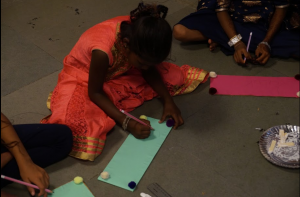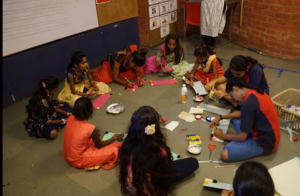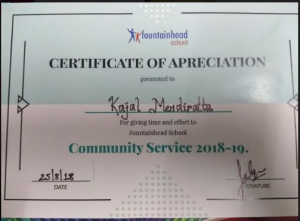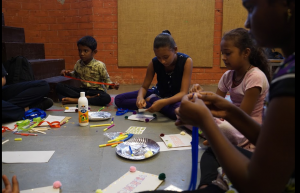Our school had decided to invite students from government schools to give them an opportunity to learn various skills of sports, arts, technology and cooking. We, the students were given a chance to volunteer for this.
Our school is located at the outskirts of the city, and surrounded by villages and few government schools. To extend our hand in the above areas and teach the students they were brought to our campus, once a week.
Since they would not able to get such an exposure, our school initiated towards a service session where we would volunteer for an activity that we intended to teach. It was a 6 week long session where every Saturday they would come and acquire knowledge with leisure. The main aim of these sessions was to help the underprivileged children who lacked these skills, to get a new exposure and learning.
Learning outcomes accomplished:
L1: Identify own strengths and develop areas for growth
I volunteered to teach art and craft. My strength was that I could easily bond with those children so that they would enjoy with me. I am patient enough to guide them in a way they are able to learn new crafts. In the process, I also developed an interest to try new crafts. Initially I had basic ideas and taught them accordingly. As we progressed, and when we were instructed to teach something that I wasn’t aware of, I would take help from a friend or search about it on the internet. This way I could develop my knowledge of art and craft and be prepared to teach them too.
L2: Demonstrate that challenges have been undertaken, developing new skills in the process
Though it was a fun and entertaining task, there were challenges that we faced. The major challenge we faced was that we had to manage students of different age groups at the same time. The older ones could comfortably do cutting, pasting and other basic things, while the younger ones couldn’t work independently. Thus we had to teach each child at their pace or at times sit with the child and make them do it. Since we were 3 people, we divided the students into groups. Another major problem we faced was that since they were from rural areas, they spoke and understood Gujarati. Unfortunately not all of us were very good at Gujarati, initially this became a concern, but luckily there were few children who understood Hindi as well. They helped us to communicate our instructions for students, by translating them to Gujarati.

L5: Demonstrate skills and benefits of working collaboratively
There were many other students who had volunteered to teach art and craft. The volunteers were from grades 7-12, and since we all had different ways of teaching a specific activity too, there were disputes that arose but focusing on the main aim we came up to common ideas and divided the children into groups. Since we had chosen to take this, we had to act in a responsible way such that we wouldn’t compromise on conveying the learning and method of the activity to be taught.

Overall it was an opportunity where not only the children but I also learnt new things and developed my skills of art and craft. We are mostly into our comfort zone and tend to forget all the issues being faced around us.
After interacting with the students, I realized that it is not a child’s fault to be born in an underprivileged family. We are fortunate to have many resources to use and a supportive family. We also have the ability to help resolve some issues by acting thoughtfully.
Even a small contribution can create a big impact. A small step of mine brought a smile on the faces of innocent children which gave me a feeling of satisfaction and pride.

